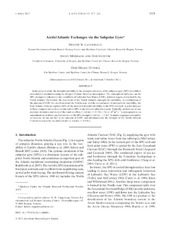Arctic/Atlantic exchanges via the Subpolar Gyre
Peer reviewed, Journal article
Published version
Permanent lenke
https://hdl.handle.net/1956/5279Utgivelsesdato
2012Metadata
Vis full innførselSamlinger
- Geophysical Institute [1198]
Originalversjon
https://doi.org/10.1175/jcli-d-11-00085.1Sammendrag
In the present study we investigate the decadal variability in the strength and shape of the Subpolar Gyre (SPG) in a 600-year pre-industrial simulation using the Bergen Climate Model. The atmospheric influence on the SPG strength is reflected in the variability of Labrador Sea Water (LSW), which is largely controlled by the North Atlantic Oscillation, the first mode of the North Atlantic atmospheric variability. A combination of the amount of LSW, the overflow from the Nordic Seas, and the second mode of atmospheric variability, the East Atlantic Pattern, explains 44% of the modeled decadal variability in the SPG strength. A prior increase in these components leads to an intensified SPG in the western subpolar region. Typically, an increase of one standard deviation (std) of the overflow (1 std = 0.2 Sv, 1 Sv = 106 m−3 s−1) corresponds to an intensification of about one half std of the SPG strength (1 std = 2 Sv). A similar response is found for an increase of one std in the amount of LSW, and simultaneously the strength of the North Atlantic Current increases by one half std (1 std = 0.9 Sv).
